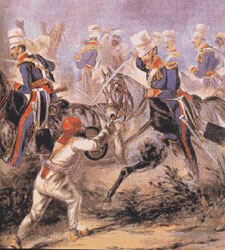 Ferozepur (Punjab), Jan 1 (IANS) Historically rich land near here containing the last vestiges of the Anglo-Sikh wars of the mid- 19th century is being lost to agriculture, rue historians. Along with bodies like the Anglo-Sikh Heritage Trail, they have urged the Punjab government to save the remnants of the seminal Anglo-Sikh war in the Sabraon area of this border district. Sabraon is about 10 km from here.
Ferozepur (Punjab), Jan 1 (IANS) Historically rich land near here containing the last vestiges of the Anglo-Sikh wars of the mid- 19th century is being lost to agriculture, rue historians. Along with bodies like the Anglo-Sikh Heritage Trail, they have urged the Punjab government to save the remnants of the seminal Anglo-Sikh war in the Sabraon area of this border district. Sabraon is about 10 km from here.
“Defences erected by the Sikh army during the first Anglo-Sikh war have been discovered by Britain-based historian Amarpal Singh Sidhu. The defences, built for the battle of Sabraon in 1846, remarkably still survive albeit in a badly faded state,” a statement by the Anglo-Sikh Heritage Trail has said.
“However, parts of these are being quickly destroyed by local farmers who are rapidly appropriating any remaining uncultivated land in the area.”
“Amarpal Singh, who has travelled extensively through Sabraon and other battlefield sites in the last few years, believes only action taken in the very near future can save the defensive fieldwork, the first to be found,” the statement said.
As per Britain-based charity Maharaja Duleep Singh Centenary Trust (MDSCT), the remnants of trenches and foxholes are under threat as local farmers are flattening land to increase the area under cultivation.
The MDSCT’s primary objective is to highlight and promote Anglo-Sikh heritage.
Gurmeet Rai, an eminent Delhi-based conservation architect, told IANS, “Though the government has protected the obelisks, which are battle markers, through funds from the ministry of tourism, there is a need for protection of the  battle features in landscape, as found by this scholar.
battle features in landscape, as found by this scholar.
“These need to be identified and interpreted properly. There is a need to engage battle archaeologists for this work,” said Rai, director of the Cultural Resource Conservation Initiative (CRCI).
Urging the Punjab government to act fast as the site could be lost within a matter of weeks, the MDSCT claims if no action is taken, no visible scar of the conflict will be left at the famous site.
The trust is in the name of Duleep Singh, the young son of famous warrior king Maharaja Ranjit Singh, who was taken by the British to England as they took over Punjab after the Anglo-Sikh wars.
Ranjit Singh, who had expanded the Sikh empire over large parts of north India, had died in 1839 and the first and second Anglo-Sikh wars were fought in 1845-46 and 1848-49. The British forces won the wars.
“The farmers have already expanded their farms right up to the banks of the Sutlej at many points, destroying and levelling any remaining evidence of the battle,” said Sarinjit Singh Bahia, a trustee of MDSCT who has extensively lectured on Anglo-Sikh wars.
The government, according to him, has an important role to play in ensuring the needs of local farmers but also in preserving the historical landscape.
“We owe it to the future generations to preserve the rich history of our country and allow them to learn firsthand the lessons it has to offer,” Bahia added.
It is believed that of all the Anglo-Sikh battlefields, only Sabraon has evidence of Sikh field defences today. Very few people visit the site and even fewer locals realise that this stretch of land - close to the India-Pakistan border - once held the famous conflict. It is widely assumed that the village of Chote Sabraon was where the battle took place.
The Sham Singh Attariwalla Gurudwara close to the village was where the great general, Sham Singh of the Sikh Army, died. In fact, he commanded the eastern end of the entrenchment and died fighting bravely within it, thus making the site of momentous historical importance, Sikh historians feel.
(Khuswant Singh can be contacted at [email protected])

